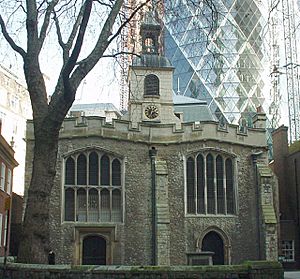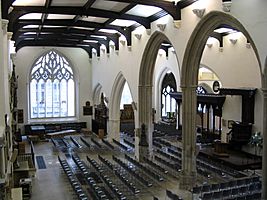St Helen's Church, Bishopsgate facts for kids
Quick facts for kids St Helen's Bishopsgate |
|
|---|---|

St Helen's Bishopsgate pictured in 2006
|
|
| Location | London, EC3 |
| Country | United Kingdom |
| Denomination | Church of England |
| Previous denomination | Roman Catholicism |
| Churchmanship | Conservative evangelical |
| Website | st-helens.org.uk |
| History | |
| Status | Parish Church |
| Architecture | |
| Functional status | Active |
| Heritage designation | Grade I listed building |
| Administration | |
| Parish | St Helen's Bishopsgate with St Andrew Undershaft and St Ethelburga Bishopsgate and St Martin Outwich and St Mary Axe |
| Diocese | London |
St Helen's Bishopsgate is an Anglican church in London. It is located in Great St Helen's, off Bishopsgate.
It is the largest surviving parish church in the City of London. Several notable figures are buried there, and it contains more monuments than any other church in Greater London except Westminster Abbey, hence it is sometimes referred to as the "Westminster Abbey of the City". It was the parish church of William Shakespeare when he lived in the area in the 1590s. It was one of only a few churches in the City of London to survive both the Great Fire of 1666 and the Blitz.
Owing to parish consolidation over the years, the parish is now named "St Helen's Bishopsgate with St Andrew Undershaft and St Ethelburga Bishopsgate and St Martin Outwich and St Mary Axe". The Worshipful Company of Merchant Taylors are the patrons of the benefice.
Today, it is home to a large congregation in the conservative evangelical tradition with a ministry to city workers, families, students and young professionals. Three English-speaking church services take place each Sunday, as well as a number of midweek talks and small group Bible studies.
The nearby churches St Andrew Undershaft and St Peter upon Cornhill are also administered by St Helen's.
Contents
History
The church of St Helen dates from the 12th century and a priory of Benedictine nuns was founded there in 1210. It is unusual in that it was designed with two parallel naves, giving it a wide interior. Until the dissolution of the priory in 1538, the church was divided in two by a partition running from east to west, the northern half serving the nuns and the southern the parishioners. It is the only building from a nunnery to survive in the City of London.
The priory had extensive monastic buildings; its hall was later used by the Worshipful Company of Leathersellers until its demolition in 1799. A crypt extended north from the church, under the hall.
In the 17th century two Classical doorcases were added to the otherwise Gothic church. In 1874 the parish was united with that of St Martin Outwich when the latter's church was demolished, and the first incumbent of the new parish was John Bathurst Deane. St Helen's church was heavily restored by John Loughborough Pearson in 1891–3, and reopened on St John the Baptist's Day in 1893 by the Bishop of London, Frederick Temple.
St Helen's was one of only a few City of London churches to survive both the Great Fire of London of 1666 and the Blitz during World War II. In 1992 and 1993, however, the church was badly damaged by two IRA bombs that were set off nearby. The roof of the building was lifted and one of the City's largest medieval stained glass windows was shattered. The church has since been fully restored although many of the older monuments within it were entirely destroyed. The architect Quinlan Terry, an enthusiast of Georgian architecture, designed the restoration along Reformation lines.
Present day
Owing to parish consolidation over the years, the parish is now named "St Helen's Bishopsgate with St Andrew Undershaft and St Ethelburga Bishopsgate and St Martin Outwich and St Mary Axe". The Worshipful Company of Merchant Taylors are the patrons of the benefice.
The church was designated a Grade I-listed building on 4 January 1950.
St Helen's Church is within the Conservative Evangelical tradition of the Church of England, and it has passed resolutions to reject the ordination of women and/or female leadership.
Memorials
- North wall of the nuns' choir, near the west end, Alderman Thon Robinson, 1599. An Elizabethan group of kneeling figures; the deceased and his wife with nine sons and seven daughters.
- In the north-east corner of the "Gresham Memorial Chapel" at the east end of the nuns' choir, altar tomb of Sir Thomas Gresham, 1579. Founder of the Royal Exchange and the Gresham Lectures.
- Side by side with the preceding, Sir Julius Caesar Adelmare, 1636. Judge of the Court of Admiralty. Altar tomb with Latin epitaph in the form of a deed to which is affixed the broad seal of the deceased.
- In the south-east corner of the Gresham Memorial Chapel, Sir Andrew Judd 1558. Founder of Tonbridge School.
- Under the chancel arch, north of the high altar, Sir William Pickering, 1574. Ambassador in the reign of Queen Elizabeth I. Altar tomb with recumbent figure surmounted by a lofty canopy.
- Under the chancel arch, south of the High Altar, Sir John Crosby 1476 founder of Crosby Hall, and Agnes his wife. Altar tomb with recumbent figures.
- In the Chapel of the Holy Ghost, Sir John Oteswich and his wife. Formerly in the church of St Martin Outwich.
- Against the south wall of the church, sightly to the west of the south entrance, Sir John Spencer and his wife, 1609. Altar tomb under a canopy with recumbent figures, and a third kneeling figure.
Organ
The organ dates from 1744 when an annuity organ by Thomas Griffin was installed. It has undergone several restorations since by builders such as George Pike England in 1810, J. C. Bishop and Son in 1910 and 1923, Hill, Norman and Beard in 1929 and 1957, and Martin Goetze & Dominic Gwynn in 1996. A specification of the organ can be found on the National Pipe Organ Register.
The organ is of notable historic significance and has been awarded a Grade II* listing by the British Institute of Organ Studies.
Organists
- Thomas Griffin 1744–1771
- George Griffin 1771–1809
- William Henry Cutler 1809–1819
- George Warne 1819–1820
- Joseph Nightingale 1820–1842/7?
- William Richard Bexfield 1848–1853
- Mr Deane 1854
- Miss A. Barton 1867
- Richard Simpkin 2004?-Present
Activities
The church holds three services each Sunday, one at 10:30 am, another at 4 pm and a 6 pm evening service. The Sunday afternoon and evening services are followed by an informal meal and opportunities to socialise.
There are also numerous small groups which meet at the church during the week. These include the "Read, Mark, Learn" (RML) groups which either study the Gospel of Mark, the Gospel of John, the Epistle to the Romans or a Bible overview over the course of a year. There is also the Central Focus group which studies a whole variety of topics and books from the Bible. The church also runs the Christianity Explored course regularly.
Rectors
Former rectors include Thomas Horton, John Bathurst Deane (the grandfather of P. G. Wodehouse) and R. C. Lucas. The current rector is William Taylor.
Curates
Current curates include Andrew Sach, Charlie Skrine, Aneirin Glyn, Jamie Child, Mickey Mantle and Philip Brentford.
Notable ministers
Rectors
- 1541 John Weste
- 1571 Thomas
- 1575 John Olivar
- 1586 ? Lewis
- 1592 Nicholas Felton
- 1600 Lewis Hughes
- 1603 Richard Ball, S.T.B.
- 1613 Thomas Downing
- 1618 Thomas Evans
- 1619 William Laurence
- 1621 Joseph Browne, A.M.
- 1635 Richard Maden, S.T.B.
- 1639 Matthias Milward
- 1642 Thomas Edwards
- 1645 Samuel Willis
- 1647 Arthur Barham
- 1663 John Sybbald, A.M
- 1666 Thomas Horton, S.T.P.
- 1674 Edward Pelling, A.M
- 1678 Henry Hesketh, A.M. (nominated Bishop of Killala, 1689).
- 1695 Thomas Willis, A.M
- 1701 Samson Estwicke. S.T.B
- 1713 William Butler, LL.B. (Prebendary of St. Pauls).
- 1773 John Naish
- 1795 Robert Watts, M.A.
- 1799 James Blenkarne, M.A.
- 1835 Charles Mackenzie, M.A.
- 1847 John Thomas How Le Mesurier, M.A. (Archdeacon of Gibraltar).
- 1849 John Edmund Cox, D.D.
- 1873–1887: John Bathurst Deane
- 1887–1909: John Alfred Lumb Airey
- 1909 Silvanus Taylor Hingston Saunders, M.A.
- 1951–1953: Ronald Goodchild
- 1953–1961: John Miller
- 1961–1998: Dick Lucas
- 1998–present: William Taylor
Curates
- 1954-1958: Gordon Jones
- 1958-1960: Peter Coleman
- 1961-1967: David Macinnes
- 1970-1973: Ian Barclay
- 1973-1978: Robert Howarth
- 1976-1981: Jonathan Fletcher
- 1977-1978: Thomas Oates
- 1978-1982: James Spence
- 1982-1984: Simon Manchester
- 1985-1995: Hugh Palmer
- 1990-1995: Justin Mote
- 1994-1996: Carrie Sandom
- 1994-1998: Richard Coombs
- 1995-1998: William Taylor, now Rector
- 1995-1998: Jonathan Juckes
- 1998-2007: Nigel Beynon
- 2000-2005: Simon Dowdy
- 2002-2005: James de Costobadie
- 2003–present: Charlie Skrine
- 2003-2007: Ben Cooper
- 2004-2011: Mark O'Donoghue
- 2004-2009: Lee Gatiss, now director of the Church Society
- 2005–present: Matt Fuller
- 2007-2017: Andrew Sach
- 2007-2012: Chris Fishlock
- 2007-2013: Paul Clarke
- 2007-2010: Andrew Towner
- 2009–present: Aneirin Glyn
- 2009-2014: Thomas Nash
- 2010-2017: Jamie Child
- 2016–present: Mickey Mantle
Images for kids
-
Sir Thomas Gresham memorial.
-
Sir Julius Caesar Adelmare memorial.
-
Sir John Spencer memorial










